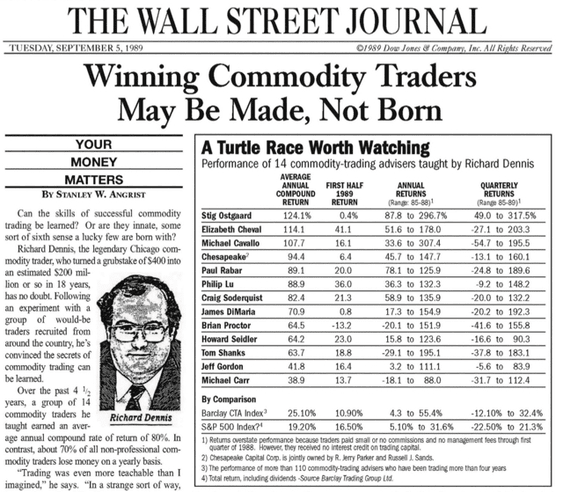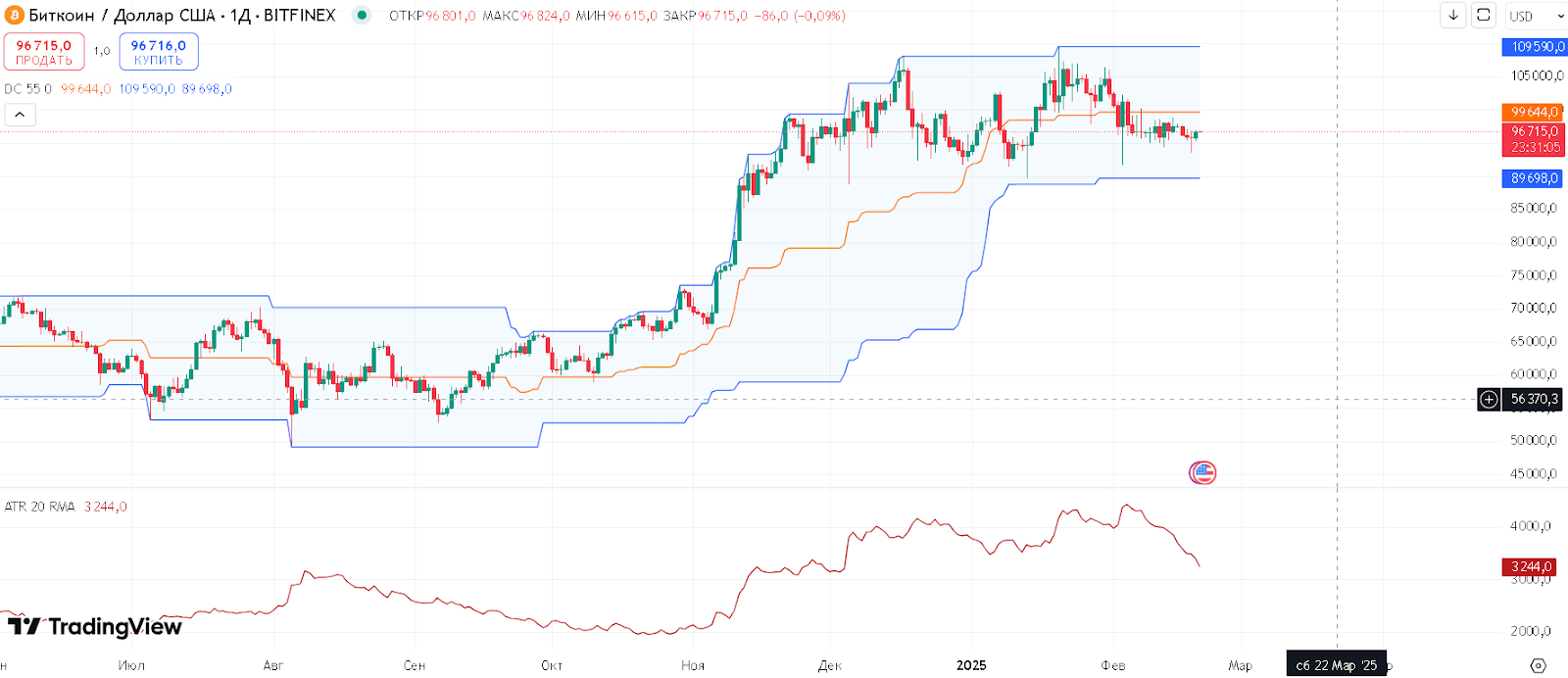 Richard Dennis was born in Chicago in 1949. He became one of the few traders to amass capital almost from scratch. As a schoolboy, he worked as a messenger, earning $40 a week; Dennis spent all his money trying to make money trading — until he realized that he needed to learn this.
Richard Dennis was born in Chicago in 1949. He became one of the few traders to amass capital almost from scratch. As a schoolboy, he worked as a messenger, earning $40 a week; Dennis spent all his money trying to make money trading — until he realized that he needed to learn this.
When the future 'king of futures' decided it was time to think through his strategy, he borrowed $1,600 from relatives. His place on the exchange cost him $1,200, and he used the remaining $400 to trade small contracts. In 1968-1969, until Dennis turned 21, his father worked on the floor instead of him, and Dennis gave him instructions with gestures. Most traders have an unsuccessful first year, but Richard was lucky. Bets on corn positions were profitable until the crop failure of 1970.
In 1970, his working capital was $3,000, and by 1973 it was already $100,000. At the age of 25, Richard Dennis earned his first million.
The fund he founded, Drexel Fund, was considered the most stable and fastest-growing for many years. After ten years, thanks to this venture, Dennis's profits reached ~$200 million. But it was the story of the 'Turtles' that truly made him famous.
What is the Turtle method?
Dennis called the students he recruited 'Turtles' to teach them using the experimental method.
In 1983, he made a $1 bet with his college friend William Eckhardt. The latter was convinced that most people would not be able to earn on the exchange, even if they were taught, because they lack intuition. Dennis, on the other hand, believed that anyone could become a successful trader regardless of personal qualities; it is only important to meet four conditions:
strict adherence to the rules;
internal discipline;
the desire to get rich;
readiness to work.
At that time, Dennis invested in a turtle farm in Florida. He came up with the name for the study group while watching baby turtles crawling in different directions from the same pit towards the water.
Dennis offered candidates relocation to Chicago and a small salary. During the selection process, they had to pass intelligence tests and an interview regarding their attitude towards risk. Of several thousand applicants, one-third already had trading experience, another third had basic knowledge, and the rest had no idea about the exchange. In total, Dennis took 23 students. In 1983, he formed the first group, and in 1984 — the second.
The first group included two novice traders, a financial consultant, two card players, an accountant, an actor, a security guard, a school graduate, a designer, a female mathematician, and an acquaintance of Dennis. Each student's trading account was $1 million. 85% of the profits went to Dennis, while 15% remained with the 'Turtles'. They could only trade with his money and had to maintain confidentiality.
Among the students of the second group, Paul Rabar, who came in second in income, and the oldest participant, 37-year-old Earl Kiefer, stood out particularly. By this time, Kiefer had been a military pilot and even a co-founder of the London International Financial Futures Exchange. For the second cohort, Dennis changed the rules: now the amounts of starting wallets differed from each other and were not disclosed. It was claimed that Dennis could allocate $50,000 to some, while others received ~$600,000.

The first year of independent work for the students did not bring significant income. But by 1985 they began to show good results. Three participants were expelled, and the remaining twenty 'Turtles' yielded ~100% average annual return. The experiment lasted five years, and its result was phenomenal: the invested $23 million brought about $175 million. Finally, in 1992, the Turtle method was declassified.
Fundamental principles of the Turtle strategy
Richard Dennis taught the 'Turtles' not to pay attention to the news and not to read financial publications, as was customary on Wall Street. The essence of the method is working with the price, liquidity, and trend of any asset. The trading system is universal, and students successfully applied it across all markets, without thinking about the nature of the product.
Dennis did not invent trend trading; he was inspired by the work of technical analysis pioneer Richard Donchian. In the 1970s, he was the first to propose the concept of trend following and developed the indicator — price channel.
It consists of three lines: upper, middle, and lower, which represent the 20-day moving average. The price corridor helps traders identify and visualize price breakouts, volatility, and trend reversals.
The Turtle strategy invented by Dennis is based on long-term trends: it allows profits to accumulate while losing trades are closed immediately upon signal. Typically, a few large successful trades form a sufficiently large annual profit to offset many small losing operations. The main indicator of the method is the current price.
Fundamental rules of the Turtle method:
a maximally simple system with a minimum of indicators is used;
the future direction of the trend does not matter; you need to earn now;
emphasis is placed on technical analysis, while fundamental analysis is completely excluded;
the task is to capture the majority of the trend, without exiting the position too early;
an aggressive method of using profits is employed — 'pyramiding'. When a trade starts to bring in profits, the existing position should be increased as long as the trend holds. Additions should be slower than the capital grows, shifting the stop order in the direction of the position;
you cannot be in a position too long. It is necessary to exit in time, avoiding overpricing and underpricing;
when determining the position size, the level of asset volatility is taken into account;
bypassing the rules is unacceptable.
Rules for opening trades according to the Turtle method
According to the Turtle strategy, entry and exit from trades occur according to clear rules. Entry into a trade can be either short-term or long-term. Regardless of which one is chosen, the purchase is made based on the fact of crossing the Donchian channel.
A short-term entry is signaled by the price crossing the 20-day level according to the indicator settings. If the breakout occurred from bottom to top — buy, if from top to bottom — sell.
An important nuance is that the trader needs to check the result of the trade based on the previous signal. If the completed trade was successful, the current signal is ignored. In that case, the opening of a position is postponed — upon crossing the higher, 55-day channel. It does not matter whether the trader entered based on the previous signal or not, the mere fact of potential result is important.
If the previous signal resulted in financial losses, the current one must be used without fail. There can be no deviation from this rule.

In long-term tactics, a breakout of the 55-day price corridor is used. Unlike the short-term entry, in this case, it does not matter whether the previous trade was a loss or a profit: the position must be opened in any case. The 'Turtles' were taught to use one unit for each trade made according to the above rules. This unit is effectively equivalent to 2% of the trading deposit. If your 'deposit' is $1,000, according to the method, you can allocate no more than $20 to each trade.
At the same time, it is necessary to consider the category of the asset. If positions are opened on two assets from the same sector — your risks are inflated. Thanks to such a system, the necessary level of risk management and the ability to participate in a large number of trades simultaneously were achieved. Rules for closing trades and risk management according to the Turtle method
Exit when implementing the short-term option occurs when the dynamics turns towards the price corridor of the lower period, that is, upon crossing the 10-day Donchian channel. Closing a long-term trade happens when breaking through the opposite boundary of the range with a period of 20.
Dennis required the 'Turtles' to enter the market randomly and manage trades. Together with Eckhardt, they worked on how students perceive money in trades with percentage ratios or absolute values. They tried to minimize the influence of emotions on decision-making, and make the reaction to losses neutral. In the Turtle method, losses can occur one after another, for example, in seven trades out of ten, while the remaining three more than cover the losses.
An important part of the 'king of futures' strategy is risk management. It begins with measuring the daily volatility of the markets. This indicator has been given the conditional name N, also known as ATR. The 'Turtles' were taught to take the maximum values of the following parameters of any market to derive the indicator N:
the distance from today's maximum to today's minimum;
the distance from yesterday's close to today's maximum;
the distance from yesterday's close to today's minimum.
If the result obtained was negative, it was brought to absolute value.
For example, if there was a breakout in corn futures at an assumed price of $250, the 'Turtles' determined the value of N for the stop. If N equals $7, then 2N would be $14. The stop-loss signal was given at a price $14 below the entry price. When buying at $250, you would need to sell at $236. No guessing, just following the rules.
If previously everything had to be calculated manually, now it is enough to add the ATR indicator to the chart in TradingView. The essence is simple: the higher the indicators, the greater the likelihood of a trend change.
For example, if on January 17, 2025, the price of Bitcoin broke the 90-day maximum at around ~$105,700. Entry according to the strategy occurs at the breakout point. A stop-loss is set according to 5ATR at $7,000 below the breakout level — ~$98,700. If the trend continues, the trader holds the position until a reverse signal appears — touching the lower red line of the 45-day Donchian.
The Turtle strategy is especially useful for traders who are willing to follow strict rules and are not afraid of holding positions for the long term. In the cryptocurrency market, it can serve as the basis for creating more complex trading systems.